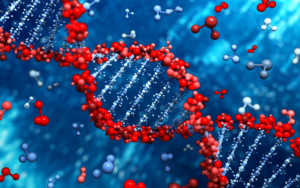Genetic mutations are intricate alterations in the DNA sequence that can have significant consequences on an individual’s development. These mutations can manifest as developmental abnormalities, which are often referred to as congenital anomalies or birth defects. In this comprehensive guide, we delve into the world of genetic mutations, exploring their role in shaping human development and how they contribute to the occurrence of developmental abnormalities.
Table of Contents
Understanding Genetic Mutations
1. Point Mutations
Point Mutations and Their Role in Genetic Mutations and Developmental Abnormalities
Point mutations, a significant category of genetic mutations, play a crucial role in the realm of genetic variations and their potential impact on developmental abnormalities. These mutations involve the alteration of a single nucleotide in the DNA sequence, resulting in a change within a gene’s coding region. Such minute changes can have profound consequences, influencing the synthesis of proteins and potentially leading to developmental anomalies.
Examples of Point Mutations and Their Implications for Developmental Abnormalities
Point mutations exemplify the intricate relationship between genetic mutations and developmental abnormalities. Consider a prime example: sickle cell anemia. This condition arises from a specific point mutation in the hemoglobin gene, leading to the substitution of a single nucleotide. This seemingly minor alteration results in the production of abnormal hemoglobin molecules, causing red blood cells to take on a characteristic crescent shape. Consequently, this mutation leads to impaired oxygen transport and a range of health complications. Another poignant instance is the mutation in the CFTR gene responsible for cystic fibrosis. A single point mutation leads to the deletion of just three nucleotides, but its ramifications are profound, causing the production of a faulty chloride channel protein and impacting various organs, particularly the lungs and digestive system.
Significance of Point Mutations in the Context of Genetic Mutations and Developmental Abnormalities
In the intricate tapestry of genetic mutations and developmental abnormalities, point mutations act as intricate threads that can drastically alter the course of human development. These small-scale changes have the potential to disrupt the delicate balance of protein synthesis, leading to a cascade of effects that manifest as congenital anomalies. By comprehending the significance of point mutations and their implications for development, researchers, clinicians, and families affected by developmental abnormalities can gain valuable insights that aid in early diagnosis, treatment, and management strategies, thereby enhancing the quality of life for individuals dealing with these challenges.
2. Frameshift Mutations
Understanding Frameshift Mutations
Frameshift mutations, a subset of genetic mutations, play a critical role in the intricate dance of DNA alterations and their impact on development. These mutations occur when a nucleotide insertion or deletion shifts the reading frame of a gene during protein synthesis. The consequences of frameshift mutations are often profound, as they can lead to the production of nonfunctional or truncated proteins. This disruption in protein synthesis can have cascading effects on cellular processes, ultimately influencing developmental pathways and potentially resulting in congenital abnormalities.
The Devastating Impact on Developmental Abnormalities
Frameshift mutations, under the umbrella of genetic mutations, are notorious for their potential to cause developmental abnormalities. For instance, consider a frameshift mutation in the CFTR gene, responsible for regulating chloride transport across cell membranes. In conditions like cystic fibrosis, a single nucleotide deletion can shift the reading frame, causing the production of a malfunctioning CFTR protein. This leads to thickened mucus in the respiratory and digestive systems, causing breathing difficulties and other complications from birth. Such examples underscore how frameshift mutations can disrupt normal development and pave the way for congenital anomalies.
Unveiling the Link between Frameshift Mutations and Genetic Aberrations
The intricate link between frameshift mutations and developmental abnormalities highlights the pivotal role of genetic mutations in shaping human health. In certain cases, frameshift mutations occur spontaneously, while in others, they can be inherited from parents. Regardless of their origin, these mutations exemplify the delicate balance that governs the genetic code and its translation into functional proteins. By delving into these complex mechanisms, researchers and medical professionals can gain deeper insights into the causes of congenital anomalies, paving the way for early detection, intervention, and potential therapeutic strategies to mitigate the impact of frameshift mutations on human development.
3. Chromosomal Mutations
Chromosomal Mutations: Unraveling the Complex Link Between Genetic Mutations and Developmental Abnormalities
Chromosomal mutations stand as one of the pivotal factors within the realm of genetic mutations that profoundly influence the landscape of developmental abnormalities. These mutations encompass large-scale alterations in the structure or number of chromosomes, impacting the delicate orchestration of human development. Such mutations can lead to an array of congenital anomalies, exemplifying the intricate interplay between genetic variations and developmental processes.
Examples of Chromosomal Mutations and their Impact on Developmental Abnormalities
The impact of chromosomal mutations on developmental abnormalities is evident through noteworthy examples. Down syndrome, arising from an extra copy of chromosome 21, showcases the intricate balance needed for proper intellectual and physical development. Turner syndrome, characterized by a missing or partially missing X chromosome in females, demonstrates how chromosomal mutations can result in distinctive features like short stature and infertility. These examples underscore the critical role of chromosomal integrity in fostering optimal development.
Navigating Developmental Abnormalities: Insights and Implications
Understanding chromosomal mutations’ role in developmental abnormalities holds paramount importance for both medical professionals and families. Timely identification of these mutations can enable informed decisions and interventions to enhance affected individuals’ quality of life. By delving into the intricacies of chromosomal mutations and their consequences, we unveil a deeper comprehension of the interconnectedness between genetics and developmental outcomes, guiding us towards more effective strategies for diagnosis, management, and potential therapeutic interventions.
Impact of Genetic Mutations on Development
Embryonic Development Disruption
Embryonic Development Disruption due to Genetic Mutations
Embryonic development is a meticulously orchestrated process, guided by a complex interplay of genetic instructions. However, the occurrence of genetic mutations can significantly disrupt this delicate dance, leading to developmental abnormalities that affect both the structure and function of developing organs. These genetic mutations can result from point mutations, frameshift mutations, or chromosomal alterations, exerting a profound impact on the trajectory of growth and differentiation.
Examples of Genetic Mutations and Developmental Abnormalities
Genetic mutations play a pivotal role in shaping embryonic development and can have far-reaching consequences. For instance, a mutation in the Sonic Hedgehog gene can lead to holoprosencephaly, a condition where the forebrain fails to divide properly during early embryogenesis. This results in facial and brain abnormalities that profoundly impact an individual’s quality of life. Another example is the mutation in the MYH7 gene, which can lead to hypertrophic cardiomyopathy – a condition characterized by thickened heart muscles that impair the heart’s pumping efficiency, underscoring the intricate connection between genetic mutations and organ development.
Understanding the Significance and Implications
The understanding of how genetic mutations disrupt embryonic development holds immense significance, as it provides insights into the origins of various congenital abnormalities. By unraveling the intricate mechanisms by which mutations interfere with normal gene expression and protein synthesis, scientists and medical professionals can devise targeted interventions and therapies. Early detection of these mutations during prenatal screenings can empower parents and healthcare providers to make informed decisions, optimizing the care and treatment of affected individuals. As research advances, the intricate relationship between genetic mutations and developmental abnormalities continues to offer new avenues for understanding human development and designing strategies to alleviate the impact of such disruptions.
Functional Protein Alterations
Functional Protein Alterations due to Genetic Mutations and Their Role in Developmental Abnormalities
Genetic mutations, pivotal drivers of developmental abnormalities, often exert their impact through functional alterations in proteins. These mutations disrupt the intricate choreography of protein synthesis and functioning, cascading into a spectrum of developmental anomalies. Point mutations, frameshift mutations, and chromosomal rearrangements are prime culprits. A striking example is the MYH7 gene mutation, implicated in hypertrophic cardiomyopathy, where altered proteins compromise heart muscle function, underscoring the profound interplay between genetic mutations and developmental integrity.
Crucial Examples of Genetic Mutations Leading to Developmental Abnormalities via Protein Alterations
Developmental abnormalities, intricately linked to genetic mutations, often arise from perturbations in proteins’ normal functioning. The NF1 gene mutation typifies this interaction, causing neurofibromatosis type 1 characterized by benign nerve tumors. Meanwhile, the MTHFR gene mutation contributes to neural tube defects, compromising folate metabolism crucial for fetal neural development. Such mutations translate into congenital anomalies, amplifying the urgency of comprehensive understanding, diagnosis, and intervention.
Navigating Developmental Abnormalities: Unveiling Genetic Mutations’ Protein Disruptions
Unraveling the intricate dance of genetic mutations and their downstream protein alterations is pivotal in comprehending developmental abnormalities. The Tetralogy of Fallot, a congenital heart defect, is emblematic of this connection, with genetic mutations in genes like NKX2.5 impairing heart development. These instances emphasize the intricate web of genetics, proteins, and developmental outcomes. By plumbing the depths of these molecular interactions, researchers and clinicians chart new avenues to decipher, predict, and potentially mitigate the impact of genetic mutations on developmental trajectories.
Dominant vs. Recessive Mutations
Dominant vs. Recessive Mutations – Unraveling the Genetic Complexity
In the realm of Genetic Mutations and Developmental Abnormalities, the dichotomy between Dominant and Recessive Mutations plays a pivotal role in shaping an individual’s health and development. Dominant mutations, carrying considerable weight, exert their effects even when only one copy of the mutated gene is present. These mutations often lead to noticeable phenotypic changes, amplifying the impact on an individual’s overall well-being. A prime example is Neurofibromatosis type 1 (NF1), where a single mutation in the NF1 gene can trigger the growth of benign tumors along nerves, significantly affecting both physical appearance and health outcomes.
The Subtle Intricacies of Recessive Mutations
On the contrasting end of the spectrum, Recessive Mutations necessitate both gene copies to be mutated for their effects to manifest. This subtlety can mask their presence, often leading to carriers who do not exhibit any symptoms. However, when two carriers of the same recessive mutation come together, as seen in consanguineous relationships, the risk of passing on the mutation to their offspring increases dramatically. An illustrative example is seen in disorders like Cystic Fibrosis, where mutations in the CFTR gene result in abnormal chloride transport across cell membranes, causing thick mucus buildup in the lungs and other organs.
A Balancing Act in Genetic Inheritance
The interplay between Dominant and Recessive Mutations showcases the intricate balancing act that defines genetic inheritance and contributes to the spectrum of Developmental Abnormalities. Genetic counselors and medical professionals navigate this landscape to provide valuable insights into potential health risks for individuals and families. Understanding the nuances of these mutation types equips us with the knowledge to predict, diagnose, and manage congenital conditions more effectively, thereby fostering a brighter future for those impacted by these genetic intricacies in the realm of developmental abnormalities.
Congenital Abnormalities Arising from Genetic Mutations
Cleft Lip and Palate: Mutations in genes like IRF6 can lead to incomplete fusion of facial structures during early development.
Example: Van der Woude syndrome, caused by mutations in the IRF6 gene, is characterized by cleft lip and palate along with other facial abnormalities.
Neural Tube Defects: Mutations affecting genes involved in neural tube closure can lead to conditions like spina bifida.
Example: Mutations in the MTHFR gene can increase the risk of neural tube defects by affecting folate metabolism.
Congenital Heart Defects: Mutations in genes that regulate heart development can lead to structural abnormalities in the heart.
Example: Tetralogy of Fallot, a complex congenital heart defect, can result from mutations in genes like NKX2.5.
Conclusion:
Genetic mutations wield immense power in shaping an individual’s development, and their influence on the occurrence of congenital abnormalities is undeniable. By understanding the various types of mutations, their impact on development, and the resulting congenital anomalies, we pave the way for early diagnosis, intervention, and potentially, therapeutic approaches that can alleviate the burden of these conditions on affected individuals and their families.




